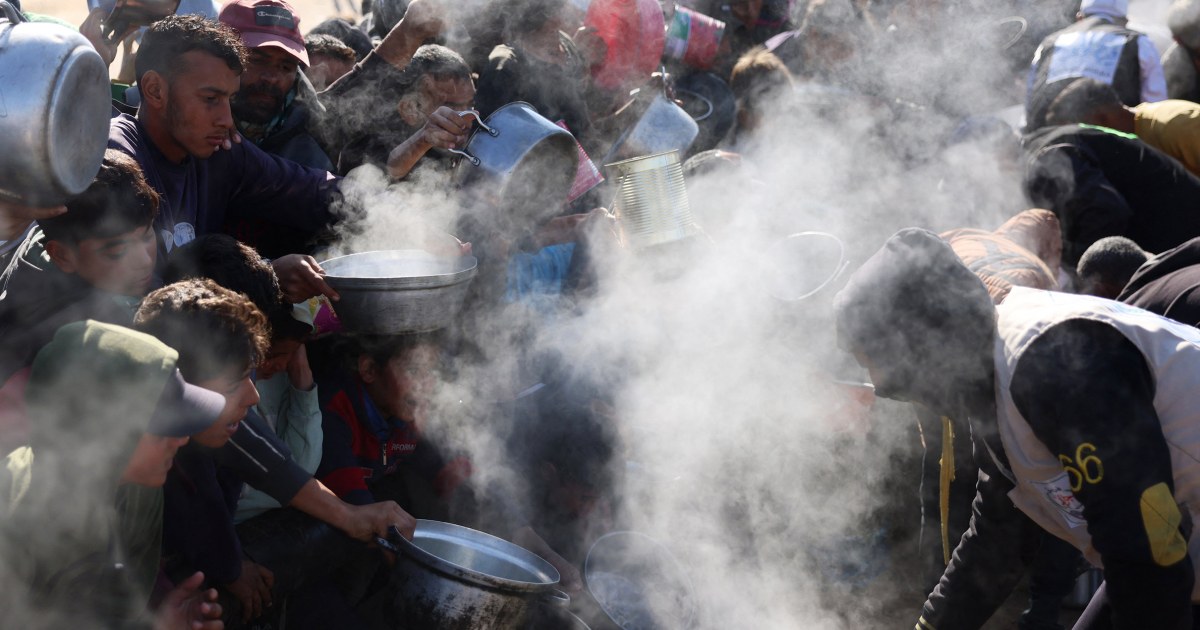Israeli fighter jets appear to have used U.S.-made munitions in a strike that killed dozens of people inside a U.N. school in the central Gaza Strip on Thursday, according to two weapons experts who examined verified footage from the debris.
World
Israel used U.S. munitions in deadly strike on U.N. school, experts say

An Israel Defense Forces spokesman said the strikes targeted a gathering of militants at the school. But the facility was also packed with thousands of civilians displaced by the war, according to the United Nations Relief and Works Agency, which aids Palestinian refugees. The Gaza Health Ministry said 40 people were killed, including 14 children and nine women, and 74 others were wounded. Khalil al-Degran, spokesman for the al-Aqsa Martyrs Hospital in nearby Deir al-Balah, said that the bodies of children killed in the strike were brought to his facility.
“We are confident that our activities were effective in limiting and reducing the harm to civilians in the area,” Lt. Col. Peter Lerner, an IDF spokesman, said at a news conference Thursday. He said that between 20 to 30 Hamas and Islamic Jihad fighters were operating from a compound inside the school, and that the strike was called off twice to limit civilian casualties.
Reviewing footage of the debris, Trevor Ball, a former explosive ordnance disposal technician for the U.S. Army, said the munition’s distinctive nose cone was used to penetrate the building’s concrete structure. Rahul Udoshi, a senior analyst on the Weapons Team at the defense firm Janes, also said the debris and holes in the building pointed to the use of the GBU-39 nose cone.
“One of its benefits is that it can penetrate concrete, penetrate buildings, and take out floors exactly like this. So essentially what you’re seeing is that solid nose cone left over after the blast,” Ball said.
But, he added, the calculations should change when you’re using a small diameter bomb in an area where civilians are “heavily present.”
Israel has drawn widespread international condemnation over the mounting civilian casualties in Gaza, where more than 36,000 people have been killed since the start of the war on Oct. 7. At least 45 people were killed in a strike on a tent camp in Rafah last month, which the IDF said targeted two Hamas officials.
Weapons experts also identified the munitions in that strike as U.S.-made GBU-39s. The fragments visible in verified images from the scene showed the cage code, or five-character sequence used to identify vendors that sell weapons to the U.S. government. The “81873” designation linked the fragment to Woodward HRT, a weapons components manufacturer registered in Valencia, Calif.
On Thursday, Shawish, 37, said he was asleep at home when he awoke to his house shaking. He walked outside and heard people screaming and calling for help. At the school, Shawish said he saw bodies on the ground, people running for safety and ambulances arriving to ferry the wounded.
People were pulling dead and injured civilians from the rubble, he said.
“The scene was truly frightening,” he said, adding that people were scrambling to pull dead and injured civilians from the rubble, and that baby diapers, food, blankets and mattresses were scattered among the debris.
Phillipe Lazzarini, Commissioner-General for the U.N.’s Palestinian refugee agency, known as UNRWA, wrote on X on Thursday that the school had been sheltering 6,000 displaced people when it was hit overnight by Israeli forces “without prior warning to the displaced.”
“Attacking, targeting or using UN buildings for military purposes are a blatant disregard of International Humanitarian law,” he wrote.
Juliette Touma, UNRWA’s communications director, said in a statement to The Post that more than 170 UNRWA buildings — mostly schools that were turned into shelters — have been hit since the war began in October, killing more than 450 people.
“We call for investigations into all violations against the United Nations including attacks on our buildings,” Touma said.
Here’s what else to know
An escalation in fighting between Israel and Hezbollah is adding to fears of a wider war, as Israeli officials say they will soon decide whether to launch an offensive at the border with Lebanon. The Israeli military said a reservist was killed in a Hezbollah rocket attack in northern Israel on Wednesday evening. Israeli strikes hit villages in southern Lebanon on Wednesday and overnight, sparking a fire, the Lebanese national news agency said.
The United States remains “incredibly concerned” about the situation on the Israel-Lebanon border, State Department spokesperson Matthew Miller said Wednesday, adding that Israel has said its “preference would be to resolve it diplomatically, but they were also prepared to do so militarily.” He said Washington continues “to pursue a diplomatic resolution because we don’t want to see that escalation of the conflict.”
Spain has asked to join South Africa’s case at the International Court of Justice on Israel’s operations in Gaza, Foreign Minister José Manuel Albares said Thursday. South Africa brought the case to the ICJ last year, accusing Israel of violating the Genocide Convention. Israel has denied the genocide charges. The top U.N. court last month ordered a halt to an Israeli offensive in Rafah.
Nine out of 10 children in Gaza are experiencing severe food poverty and surviving on two or fewer food groups a day, according to a UNICEF report published Thursday. “Months of hostilities in the Gaza Strip have brought the food and health systems to collapse and have had a catastrophic impact on children and families,” UNICEF said. The closure of the Rafah border crossing has restricted access to food and medical supplies, and U. S-led negotiations to reopen the crossing for aid deliveries face significant obstacles, The Post reports.
Thousands of ultranationalist Israelis marched through Jerusalem’s Old City on Wednesday for the annual Flag March, which draws settlers and other right-wing activists to mark the 1967 Israeli capture of the eastern part of the city. Some chanted anti-Arab slogans including “Death to Arabs,” the Associated Press reported. Israeli police arrested 18 people on suspicion of violent crimes, assault and threats, and disorderly conduct.
At least 36,586 people have been killed and 83,074 injured in Gaza since the war started, according to the Gaza Health Ministry, which does not distinguish between civilians and combatants but says the majority of the dead are women and children. Israel estimates that about 1,200 people were killed in Hamas’s Oct. 7 attack, including more than 300 soldiers, and it says 293 soldiers have been killed since the launch of its military operations in Gaza.
Loveluck reported from London; Masih from Seoul; Melnick from London; and Berger from Jerusalem. Ellen Francis in London and Lior Soroka in Tel Aviv contributed to this report.








